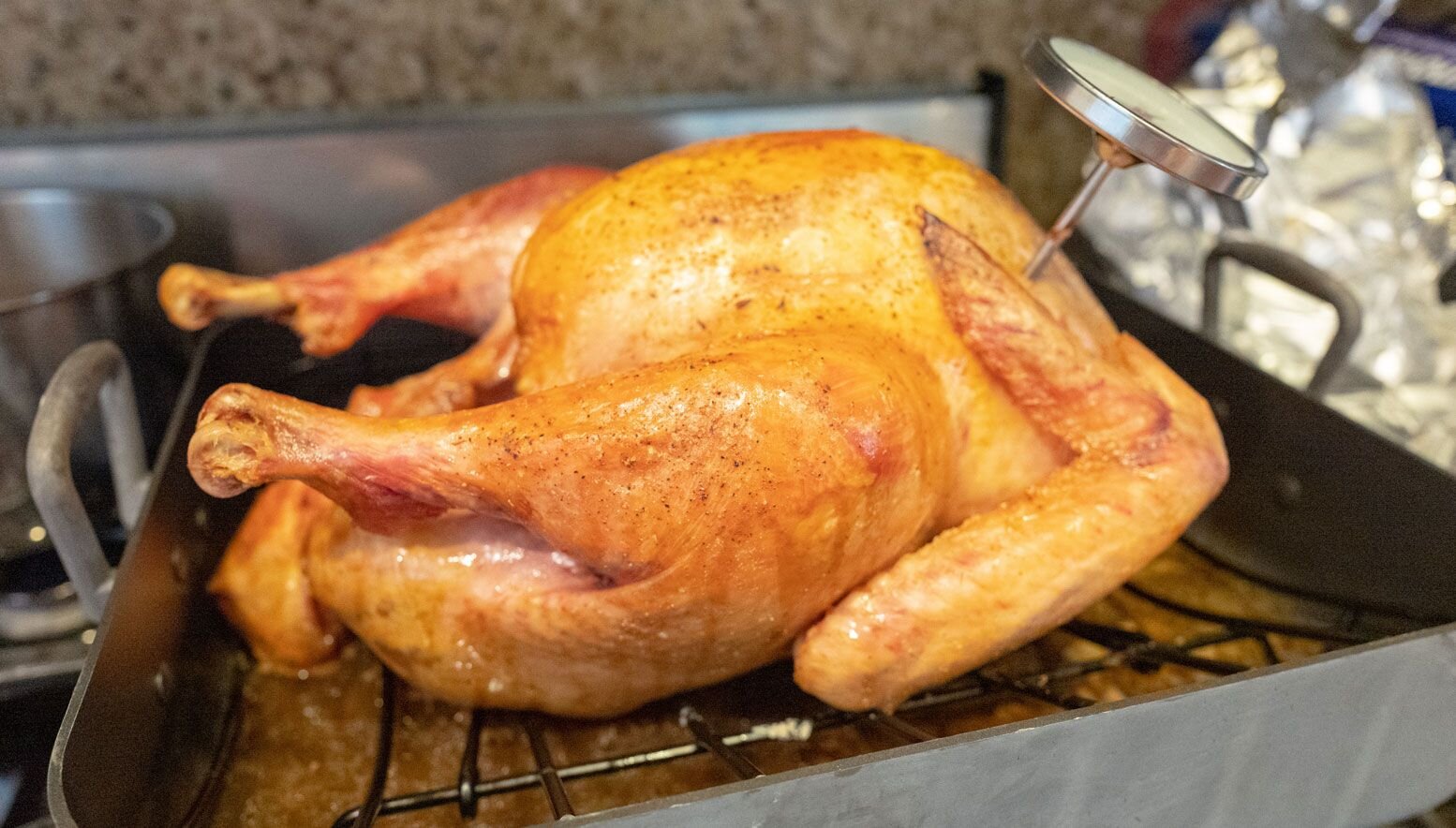Just a few feet away from where I am sitting on the couch right now, my enemy lies in wait. It isn’t hiding—I put it where it is now—but it is looming, a menacing adversary just waiting to take its toll on me. I did nothing to deserve this vengeance, but there’s no way around it. Even though the odds are against me, I don’t have a choice. I am being given a nearly thankless task on a day when we are supposed to focus on thankfulness.
Like it or not, it is what it is: I have to figure out how to successfully cook a turkey.
I don’t think it’s any accident that most folks only cook a whole turkey once or twice a year. I’ve been on turkey duty now for almost two decades, and it never gets any easier. First you have to buy a bird, and if it’s frozen, you’ll have to defrost it, which can take a few days in the refrigerator. (That’s if you can fit a turkey in your refrigerator.) Then you have to address your pre-cooking situation—to brine, or not to brine? All of that is before you actually cook the darn thing, which brings up a whole other set of questions: What temp? How long? Should I inject? Dry rub?
There’s nothing wrong with turkey as a food item, in and of itself. It’s actually pretty healthy—leaner than chicken, low in fat and high in protein. It doesn’t have a lot of distinct flavor, at least the white meat, but it does serve as a good delivery method for gravy, which is especially important in the winter.
But somewhere along the way, it was decided that we should all have gorgeous mahogany turkeys on our tables. I don’t know who decided upon this unrealistic standard of poultry beauty, but it just isn’t fair. It’s almost as though you have to choose: You can have a turkey that looks great, or you can have a turkey that tastes good. But achieving both of those goals simultaneously is very difficult.

Why? To get the skin crisp and brown, you need high heat. To get the meat succulent and juicy, you need low heat. This doesn’t even account for the uneven shape of a turkey, which is akin to a small garden boulder, which makes it challenging to achieve an even burnished skin, without having to rotate the bird or flip it around.
I’m not even convinced the turkey was created to be cooked, at least not in a home kitchen. Chickens, I get, because they’re small enough to cook in under an hour, and achieving the goals I listed above aren’t completely impossible if you blast the heat. They’re also small and easy to catch and dispatch. Turkeys, on the other hand, are mildly terrifying animals, with bits of wobbly flesh hanging from all over their heads and an alarming riot of feathers sprouting from their butts. Their very appearance seems to tell us to steer clear, and yet we persist.
As chefs, why do we put ourselves through all of this? I speak for many home cooks when I say this, but I think it is at least partly because we want to make our family and friends happy. This feeling may be a bit misguided—I don’t think people’s feelings actually change based on whether or not I can conjure up a Norman Rockwell-looking bird—but in general, cooking is one reliable way that I know of to please people in my life. On most weeknights, I find some peace posting up in the kitchen and making something good to eat. Thanksgiving usually creates the opposite feeling—they should have a Headspace series specifically for people running the holiday kitchen—but I sign up year after year because I am confident my work is worth the trouble.
I’ve attempted pretty much every turkey preparation there is, with varying levels of success, attempting to get a picturesque protein on my holiday table. And finally, this year I have given up. It’s 2020, it seems like a compromise should be in order. Let’s make a deal: I’ll get a turkey on the table that will taste great and have some delicious crispy skin, and I’ll even throw in some savory brown gravy made from the turkey drippings. It might not look picture perfect, that I am willing to concede, but all the other stuff I will deliver. Deal?
So this year, I am spatchcocking my turkey. What does that mean? It means I’m going to butterfly it. What does that mean? It means I’m going to cut the backbone out and do my best to physically mangle the turkey into a large, flat sheet of meat. This will, in turn, allow the meat to roast evenly, while at the same time presenting a smooth surface of skin that should brown evenly. Along the way I can use a few tips and tricks learned in my old life of cooking whole birds to get some added flavor into the meat, but when it’s done I will carve it into delectable pieces and serve it on a huge tray.
Will anyone’s life be worse for the wear because they didn’t get to see a perfectly cooked whole turkey? I doubt it. Will anyone’s life be better because they ate some great turkey and, for a few minutes at least, laughed and forgot about 2020?
I sure hope so. And I know mine will. Happy Thanksgiving, you turkeys.
